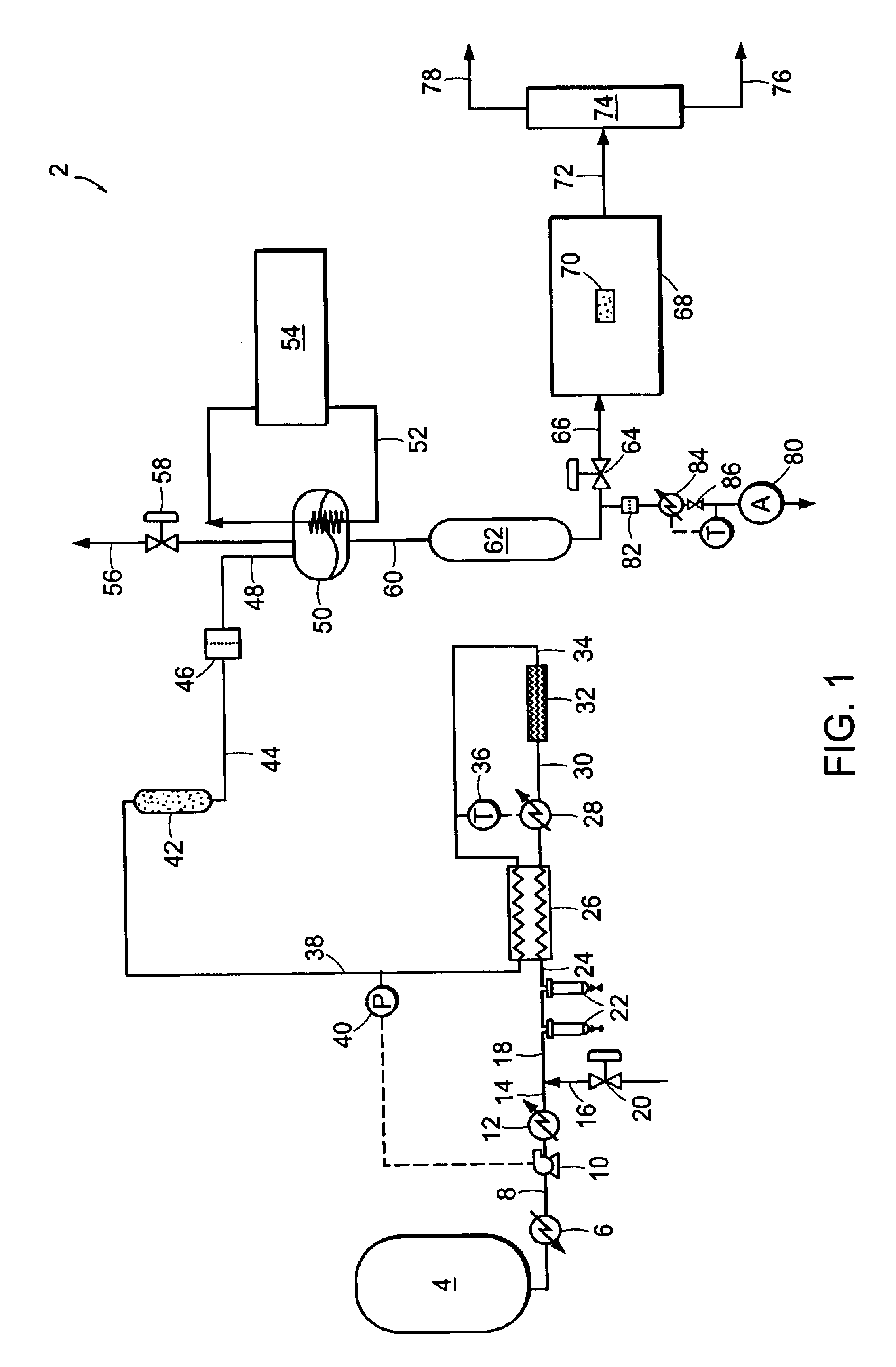Method for moving contaminants from gases
a technology for moving contaminants and gases, applied in the direction of cleaning with liquids, bulk chemical production, separation processes, etc., can solve the problems of interfering with carbon dioxide applications of contaminated particles, and achieve the effect of effectively removing soluble contaminants and lowering contaminant levels
- Summary
- Abstract
- Description
- Claims
- Application Information
AI Technical Summary
Benefits of technology
Problems solved by technology
Method used
Image
Examples
example 1
[0090]Carbon dioxide was purified in a system similar to system 2 illustrated in FIG. 1. Carbon dioxide was drawn from the vapor space of a carbon dioxide cylinder containing SFE grade carbon dioxide. The cylinder contained saturated liquid at ambient temperature, and a pressure of approximately 820 psia (˜5654 kPa). The vapor was then passed through coalescing filters operating at cylinder pressure. This stream was reduced in pressure and passed through a 0.003-micron electronics grade particle filter for removal of solid particles. Heat was applied upstream of the pressure reduction device to ensure that the carbon dioxide entering a downstream particle analyzer was approximately ambient temperature. FIG. 5 shows the particle counts as a function of the pressure to which the stream was reduced. At the highest pressure, the reduction in pressure is minor and so is the number of particles. This is consistent with the use of high efficiency coalescers. However, as the pressure is red...
example 2
[0091]EIG carbon dioxide liquid at 300 psig (˜2068 kPa) was drawn from a bulk tank, vaporized, and passed through a thermal catalytic reactor. The catalyst reactor included three PRO*VOC 10 catalysts from Süd-Chemie Prototech, Inc. (Needham, Mass.). PRO*VOC 10 catalyst is a platinum-based metal on ceramic foam. The reactor was operated at various temperatures, from ambient (˜21.1° C.) to 315.6° C. The space velocity in all tests was 44,000 scfh / ft3 (44,000 standard cubic meters per hour per cubic meter of catalyst volume). Oxygen was added to the carbon dioxide upstream of the reactor to yield 600 ppm by volume oxygen in the mixture.
[0092]FIG. 6 shows the particle size distribution as a function of reactor temperature, where the particles were measured downstream of the reactor at ambient temperature and approximately the same pressure as the reactor. The number of particles measured when the reactor was at essentially room temperature is very high. However, the number of particles ...
example 3
[0096]EIG carbon dioxide was passed through a catalytic reactor, containing three PRO*VOC 10 catalysts (Pt-based metal on ceramic foam) as described in Example 2, again without coalescence prior to the reactor. The temperature of the reactor was 600° F. (315.5° C.), and excess oxygen (˜600 ppm by volume) was added to the stream. Under these conditions, particle counting at reactor pressure and ambient temperature showed essentially complete extinction of particles.
[0097]FIG. 8 shows a concurrent analysis of the stream in a low pressure particle analyzer operating at near ambient temperature and pressure, at two space velocities. The particle count in the vapor fed to the catalytic system is in excess of 107 per cubic foot (about 353 million particles per cubic meter) when measured at normal temperature and pressure. Downstream of the reactor it is reduced to about 600 and 100 particles per cubic foot (about 21,000 and 3,500 particles per cubic meter, respectively) when measured at N...
PUM
| Property | Measurement | Unit |
|---|---|---|
| diameter | aaaaa | aaaaa |
| temperatures | aaaaa | aaaaa |
| temperatures | aaaaa | aaaaa |
Abstract
Description
Claims
Application Information
 Login to View More
Login to View More - R&D
- Intellectual Property
- Life Sciences
- Materials
- Tech Scout
- Unparalleled Data Quality
- Higher Quality Content
- 60% Fewer Hallucinations
Browse by: Latest US Patents, China's latest patents, Technical Efficacy Thesaurus, Application Domain, Technology Topic, Popular Technical Reports.
© 2025 PatSnap. All rights reserved.Legal|Privacy policy|Modern Slavery Act Transparency Statement|Sitemap|About US| Contact US: help@patsnap.com



